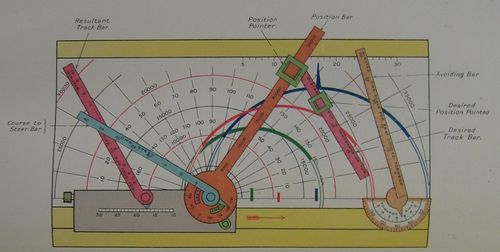Renouf Torpedo Tactical Instrument Type B
The Type B ("B" standing for "Battleship") was a more elaborate version of the Renouf Torpedo Tactical Instrument Type A, intended for use in battleships and battlecruisers.
Although it could be used to solve the attack problems the Type A focused on, its primary value was to help gauge the risk of enemy torpedo attack. In this way, it was a defensive instrument.[1]
Mechanical Design

The Type B was issued with 2 sets of torpedo circles, one for British torpedoes and one for what were thought to be possible settings for German torpedoes which were deemed equivalent to British 21-in Marks V and VI.[3]
Otherwise, the Type B was nearly identical to the Type A, adding just one more bar.[4]
The Avoiding Bar
The new bar, called the Avoiding Bar, was pivoted on a slider free to slide along the base line. It was marked in "time in minutes" for a given speed of attacking torpedo, with zero being at the pivot. The slider for the avoiding bar had a fixed semi-circular graduated disc that could be read off a pointer on the bar in either degrees or compass points.
The design was such that when the avoiding bar's slider was moved to the center of the torpedo circle in question and aligned to point to where the position bar crossed the torpedo circle, it was then parallel to the torpedo track and the pointer would show how many points the target would have to turn, and in which direction, to comb the torpedo track if it were fired at that moment. The avoiding bar's pivot slider could then be slid until it meets the position pointer, and the running time in minutes of the torpedo read off.
The "B" augmented the functionality of the "A" by permitting these defensive problems to be illustrated:[5]
- are we within range of enemy torpedoes?
- if so, what course change is sufficient to cause them to fall short?
- what is the track angle of the enemy's torpedo, in case I want to comb the wakes?
- how long until his torpedo crosses my track?
Determine if we are within range of the attacker's torpedoes

This is the same as the first attack problem illustrated on the Type A above if we apply our own speed to the target ship and align the position bar to the enemy bearing.
Determine a course change that will allow us to draw out of range
This could be easily worked by setting the instrument as above. One would then swing the position bar until the position pointer fell outside of all torpedo circles. The bearing the position bar now indicates is the bearing one must place the attacker on to place him out of range at the present moment. Another way of stating this is that the angle you have to adjust the position bar to place the attacker outside the torpedo circle is the angle you must turn away from him.
Determine the track angle of the attacker's torpedo
The prospect of choosing to comb the wake of an incoming torpedo requires one to understand that, referring to Figure III at the top of the page, that the torpedo has to travel along the line XE.
Special note was drawn to the observation that a torpedo at a track angle of 90 degrees which was 500 yards distant could not be avoided by use of the helm.[7]
Determine how long until the torpedoes cross our track
Referring to Figure III at the top of the page, if the torpedo is fired from point O, the running range of the torpedo is the length of line OT. If we divide this length by the running speed of the torpedo, we will determine the torpedo's time-of-flight.
If we consider the example image:
- enemy destroyers are plotting at 14,000 yards, bearing 40 degrees
- the enemy is equipped with a torpedo that can travel 15,000 yards are its 25 knot setting
- avoiding bar's pivot is slid to the center of the appropriate torpedo circle and rotated to where the position bar crosses the torpedo circle
- the avoiding bar indicates a turn of 6 points toward the enemy will comb the torpedo track
- the avoiding bar is then slid along the base line to the dotted position when it crosses the position pointer and indicates it will take 11 minutes for the torpedoes to reach our track
History and Deployment
These were apparently only allocated after the war. In 1919, six were to be manufactured by Elliott Brothers and allocated in this order: Vernon, Queen Elizabeth, Revenge, Barham, Lion and Iron Duke.[9]
See Also
Footnotes
- ↑ Annual Report of the Torpedo School, 1918. p. 181.
- ↑ Annual Report of the Torpedo School, 1918. Plate 125.
- ↑ Annual Report of the Torpedo School, 1918. p. 186.
- ↑ Annual Report of the Torpedo School, 1918. p. 185.
- ↑ Annual Report of the Torpedo School, 1918. p. 181.
- ↑ Annual Report of the Torpedo School, 1919. Plate 54.
- ↑ Annual Report of the Torpedo School, 1918. p. 186.
- ↑ Annual Report of the Torpedo School, 1918. Plate 126.
- ↑ Annual Report of the Torpedo School, 1919. p. 118.
Bibliography
- H.M.S. Vernon. Annual Report of the Torpedo School, 1917. Originally C.B. 1474. Copy 7 at The National Archives. ADM 189/37.
- H.M.S. Vernon. Annual Report of the Torpedo School, 1918. C.B. 1527. Copy 143 at The National Archives. ADM 189/38.
